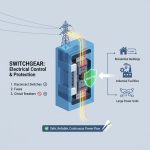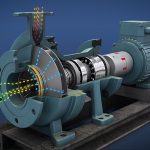The global switchgear market stands at a pivotal juncture in 2025, representing one of the most dynamic and rapidly evolving sectors within the electrical infrastructure industry. With market valuations ranging from $113.8 billion to $204.9 billion depending on methodology and scope, this critical segment of power distribution technology is experiencing unprecedented growth driven by the convergence of urbanization, renewable energy integration, and digital transformation. For investors, manufacturers, utilities, and infrastructure developers seeking to navigate this complex landscape, understanding the multifaceted dynamics of the switchgear market has become not just advantageous—but essential.
The switchgear industry encompasses far more than simple electrical switching devices. These sophisticated systems serve as the backbone of modern power distribution networks, protecting equipment from overloads, controlling power flows, and ensuring the safe and reliable delivery of electricity across residential, commercial, and industrial applications. As global electricity demand surges and power systems become increasingly complex, the role of advanced switchgear technology has evolved from a passive protective measure to an active, intelligent component of smart grid infrastructure.
Get a Sample Copy of Research Report (Use Corporate Mail id for Quick Response): https://www.vantagemarketresearch.com/switchgear-market-1635/request-sample
Our latest Switchgear Market Research Report delivers:
- Granular analysis across low, medium, and high voltage segments.
- Regional breakdowns with growth trajectories through 2035.
- Competitive intelligence on key players and strategic moves.
- Technology trends including SF6-free solutions and digital integration.
- Procurement strategies to mitigate supply chain risks.
Market Magnitude and Growth Trajectory
The switchgear market’s explosive growth trajectory reflects fundamental shifts in global energy infrastructure. Market projections indicate the sector will reach between $113.8 billion and $204.9 billion by 2025-2035, representing compound annual growth rates ranging from 5.50% depending on market segment and regional focus. This substantial expansion is underpinned by multiple converging factors that are reshaping the electrical infrastructure landscape globally.
North America emerged as a dominant force in 2024, capturing a 37.9% revenue share driven by aggressive grid modernization initiatives and federal infrastructure investments. The U.S. market alone benefits from the Bipartisan Infrastructure Law’s allocation of $65 billion for smart grid technologies and digital switchgear deployment. These investments address critical needs for grid resilience, particularly in wildfire-prone regions where utilities are prioritizing pad-mounted switchgear and advanced recloser technologies.
However, the Asia Pacific region commands the spotlight as both the largest market holder with a 46.75% to 49% share in 2024 and the fastest-growing region with projected CAGRs of 8.06% to 8.7% through 2030. China’s ultra-high voltage corridors operating at 500-800 kV DC and India’s Revamped Distribution Sector Scheme channeling $40 billion toward distribution upgrades exemplify the scale of investment driving regional growth.
Voltage Segmentation Dynamics
The switchgear market’s segmentation by voltage class reveals distinct growth patterns and application priorities. Low-voltage switchgear maintained the largest share at 43.34% to 69.2% in 2024, reflecting its ubiquitous deployment in distribution networks, industrial facilities, and commercial buildings. These systems provide the critical link between power sources and end-users, with growing emphasis on smart, flexible configurations that accommodate decentralized generation and energy management systems.
Medium-voltage switchgear, operating in the 3kV to 40kV range, represents a particularly dynamic segment valued at $14.5 billion in 2021 and projected to reach $31.7 billion by 2031 with a CAGR of 8.2%. This voltage class serves as the workhorse of industrial power distribution, with the 6kV to 15kV range dominating applications in manufacturing, mining, and commercial infrastructure. The rapid expansion of distributed energy resources and smaller-scale solar installations continues to fuel demand in this segment.
High-voltage switchgear, while holding a smaller market share, exhibits the fastest growth rate at 7.99% CAGR, outpacing other voltage classes. Investment in transmission-grid reinforcement, cross-border interconnectors, and renewable pooling stations operating at 220-765 kV classes drives this acceleration. Utilities worldwide are upgrading high-voltage infrastructure to reduce transmission losses and accommodate large-scale renewable energy projects, particularly wind farms and solar arrays requiring robust grid connections.
Insulation Technology Evolution
Insulation technology represents a critical differentiator in switchgear performance, safety, and environmental impact. Air-insulated switchgear (AIS) currently holds the dominant position, valued for its cost-effectiveness, ease of installation, and proven reliability across diverse applications. The segment’s leadership position stems from widespread adoption in distribution networks and industrial facilities where space constraints are manageable and outdoor installation is feasible.
Gas-insulated switchgear (GIS) emerges as both the second-most dominant and fastest-growing subsegment, propelled by its compact design, enhanced safety features, and superior performance in harsh environments. With a projected CAGR of 7.1%, GIS technology addresses critical needs in urban environments where space optimization is paramount. Major metropolitan areas increasingly favor GIS for substations, with applications ranging from data centers requiring compact, high-interruption-capacity equipment to offshore wind platforms demanding weather-resistant solutions.
The industry faces a significant inflection point regarding SF₆ gas emissions. The European Union’s F-gas phase-out initiative targeting SF₆-free GIS is expected to impact the global CAGR by +1.20%, driving rapid commercialization of alternative technologies. Vacuum-insulated and solid-insulated switchgear are emerging as key future players, offering cleaner, safer, and more environmentally responsible solutions. These SF₆-free alternatives are gaining traction as regulatory pressures intensify and corporate carbon pledges accelerate adoption of sustainable technologies.
End-User Application Landscape
The transmission and distribution utilities segment commanded 37.58% of 2024 revenue and exhibits the highest CAGR at 6.63% through 2030. Utilities face mounting pressure from performance-linked funding mechanisms and renewable mandates, compelling adoption of condition-based maintenance, IEC 61850 interoperability standards, and greenhouse gas emission reduction strategies. Grid modernization programs in emerging economies, coupled with aging infrastructure replacement in developed markets, sustain robust demand from this critical end-user segment.
Industrial applications, particularly in semiconductors and electric vehicle gigafactories, drive medium-voltage demand for specialized switchgear with clean-room compatibility and partial-discharge-free operation. The manufacturing sector’s increasing automation and digitalization requirements necessitate advanced switchgear systems capable of supporting sophisticated production processes while maintaining high reliability standards.
The commercial sector experiences explosive growth alongside hyperscale data center rollouts and smart building retrofits. Data center demand represents a particularly lucrative opportunity, with AI workloads lifting rack densities and prompting requirements for compact, high-interruption-capacity switchgear with real-time condition monitoring. The data center impact on switchgear demand is projected to influence the CAGR by +1.80% in North America and Europe over the medium term.
DC Switchgear: The Rising Star
While AC switchgear dominates with 84.57% of 2024 shipments, DC switchgear emerges as a high-growth specialty segment projected to expand from $17.2 billion in 2025 to $32.6 billion by 2035 at a 6.6% CAGR. This accelerated growth stems from multiple converging applications, with electric vehicle charging infrastructure standing out as the most lucrative vertical, reflecting a CAGR of 7.8%.
The rapid electrification of transportation sectors, driven by regulatory mandates and large-scale charging corridor deployments, fuels exponential demand for high-performance, compact, and digitally monitored DC switchgear. Fast and ultra-fast charging stations operating within 400V to 1000V ranges require robust switchgear with minimal switching lag and high thermal endurance. The 1800V to 3000V voltage range specifically is set to become the most lucrative DC segment with a 7.9% CAGR, primarily fueled by utility-scale solar PV plants, large EV charging hubs, and grid-level battery energy storage systems.
Power distributor switch breakers within the DC switchgear market are gaining exceptional traction, growing at 7.8% CAGR and poised to capture significant market share. This growth is underpinned by rising integration of renewable energy systems, smart grids, and distributed energy storage requiring compact, modular, and high-endurance switchgear solutions. The withdrawable deployment segment, projected to grow at 7.7% CAGR, enables safe and rapid disconnection without full system shutdown, proving indispensable in mission-critical applications across railways, battery storage, and industrial automation.
Regional Market Dynamics
Asia Pacific’s market leadership extends beyond sheer size to encompass the most dynamic growth opportunities. India’s switchgear market exemplifies this potential, expected to achieve the highest growth rate during the forecast period owing to rapid urbanization, industrial expansion, and government initiatives including Power for All and Smart Cities Mission. The nation’s $40 billion RDSS allocation for distribution switchgear through 2028 targets smart meter deployment, feeder segregation, and switchgear replacements aimed at reducing technical and commercial losses below 15%.
China’s infrastructure investments in 500 kV UHV corridors and 800 kV DC projects requisition substantial high-voltage GIS capacity, while Southeast Asia’s ASEAN Power Grid initiative promotes cross-border interconnections to improve regional energy security. Japan and South Korea demonstrate preference for compact SF₆-free GIS suitable for tight urban substations and offshore wind export platforms, incorporating remote monitoring analytics for fault prediction.
European markets are propelled by aggressive decarbonization goals, widespread electrification, and renewable energy transition. The European Union’s Green Deal and stringent environmental regulations accelerate adoption of digital and environmentally sustainable switchgear systems. The United Kingdom specifically is expected to grow at the fastest CAGR within Europe during the forecast period, driven by net-zero emission commitments by 2050, offshore wind farm investments, expansion of energy storage systems, and electric rail network development.
The UK market growth at 6.3% CAGR through 2035 is further bolstered by technological progress in DC micro-grid technology and increasing demand for compact, modular switchgear in battery energy storage systems for commercial and residential applications. Germany, France, and Italy hold prominent positions with growth supported by renewable energy regulatory ecosystems, electric mobility infrastructure investments, and adoption of energy-efficient electrical components.
Technology and Innovation Frontiers
Digital transformation represents perhaps the most significant evolutionary force reshaping the switchgear landscape. The integration of IoT, artificial intelligence, and predictive maintenance technologies revolutionizes switchgear efficiency and reliability. AI-powered condition monitoring enables utilities and industrial facilities to shift from reactive to proactive maintenance strategies, reducing downtime and operational costs while extending equipment lifespan.
Smart switchgear systems equipped with digital twins and real-time monitoring capabilities provide unprecedented visibility into power distribution networks. These intelligent systems facilitate remote diagnostics, automated fault isolation, and dynamic load management—capabilities essential for modern grid operations. Vendors offering vertically integrated supply chains, digital twin technology, and predictive maintenance capabilities are gaining market share as construction programs demand compressed delivery schedules.
The shift toward modular, plug-and-play architectures addresses the proliferation of edge computing sites and distributed energy resources. These standardized, pre-engineered solutions reduce installation time, minimize customization costs, and enable rapid deployment—critical factors for data center operators and renewable energy developers operating on aggressive timelines. Modular designs facilitate scalability, allowing operators to expand capacity incrementally as demand grows without major infrastructure overhauls.
Technological advancements in arc-quenching mechanisms, solid-state components, and insulation materials enhance DC switchgear performance while reducing maintenance requirements. Innovations in these areas improve reliability, compactness, and fault isolation capabilities—attributes increasingly valued as power systems incorporate higher proportions of DC-based generation and storage. The development of semiconductor-based solid-state circuit breakers promises even more rapid fault interruption and enhanced controllability compared to traditional mechanical systems.
Market Challenges and Constraints
Despite robust growth prospects, the switchgear market confronts significant challenges that could temper expansion. SF₆-free interrupter capacity shortages present acute supply constraints, with lead times exceeding 72 weeks in some markets, negatively impacting CAGR projections by -1.40% globally, particularly in North America and Europe. This bottleneck stems from the industry’s transition away from SF₆ gas combined with limited manufacturing capacity for alternative technologies.
Raw material price volatility, particularly for copper and cold-rolled grain-oriented (CRGO) steel, pressures low-voltage OEM margins by an estimated -0.80% impact on CAGR, with severe effects in Asia Pacific. These commodity price fluctuations create uncertainty for manufacturers and project developers, complicating long-term planning and potentially delaying infrastructure investments.
Regulatory fragmentation across jurisdictions creates compliance complexities for international manufacturers. The lack of harmonized standards for emerging technologies like SF₆-free switchgear and smart grid interoperability requires companies to maintain multiple product variants and navigate diverse certification processes. This fragmentation increases development costs and slows market entry for innovative solutions.
Cybersecurity risks associated with digital switchgear systems represent an emerging concern as critical infrastructure becomes increasingly networked. The integration of IoT sensors, remote monitoring capabilities, and grid connectivity expands attack surfaces that malicious actors could exploit. Utilities and industrial facilities must invest in robust cybersecurity measures, adding costs and complexity to switchgear procurement and operation.
Counterfeit and substandard products, particularly in emerging markets, undermine safety and reliability while eroding market opportunities for legitimate manufacturers. The prevalence of informal exporters producing low-voltage units that fail to meet safety standards negatively impacts the CAGR by -0.30% in Africa and other emerging markets.
Investment and Growth Opportunities
The switchgear market presents multiple high-potential investment opportunities across technology, geography, and application segments. Smart grid and digitalized DC switchgear solutions represent particularly attractive prospects, with early adopters of AI-powered condition monitoring, remote diagnostics, and predictive maintenance positioned to capture premium market share. The combination of these capabilities with SF₆-free switchgear technologies addresses both environmental sustainability mandates and operational efficiency requirements.
Renewable energy integration creates sustained demand for specialized switchgear capable of managing variable generation profiles and bi-directional power flows. Utility-scale solar farms, offshore wind installations, and battery energy storage systems require sophisticated switchgear with advanced protection algorithms and grid synchronization capabilities. Companies developing turnkey solutions that integrate switchgear, control systems, and energy management platforms can capture significant value in this expanding market.
The electric vehicle charging infrastructure boom offers exceptional growth potential, with DC switchgear demand driven by fast-charging and ultra-fast-charging station deployments. Network operators require rapid fault isolation, consistent load handling, and modular scalability—attributes intrinsic to advanced DC switchgear systems. Integration of renewable energy into EV charging hubs further necessitates dynamic grid management, strengthening demand for intelligent DC infrastructure.
Emerging applications in defense systems, underground metro networks, and marine electrification offer specialized growth paths. While these sectors may not match EV infrastructure’s velocity, they demand premium, mission-critical switchgear with stringent reliability and safety requirements. Manufacturers capable of meeting aerospace-grade or military specifications can command higher margins in these niche markets.
Competitive Landscape and Strategic Positioning
The switchgear market maintains a moderately concentrated competitive structure, with global majors including ABB, Siemens, Schneider Electric, Mitsubishi Electric, and General Electric leveraging patented technologies, vertically integrated manufacturing, and extensive service networks to defend market positions. ABB’s $2.1 billion acquisition of Siemens Energy’s grid-automation business in January 2025 exemplifies the consolidation trend, expanding ABB’s IEC 61850 switchgear portfolio and boosting SF₆-free capacity.
Schneider Electric’s announcement of an $800 million switchgear plant in Tamil Nadu focused on medium-voltage solid-dielectric products demonstrates the strategic importance of localized manufacturing and SF₆-free technology development. Such investments position leading players to capitalize on emerging market growth while addressing environmental regulatory requirements.
Regional challengers like LS Electric and CG Power gain domestic traction by aligning with government localization mandates in key markets including India, South Korea, and Southeast Asia. However, these players must invest substantially in alternative-gas patents and digital capabilities to compete effectively in developed markets where technology leadership and sustainability credentials drive purchasing decisions.
Niche specialists targeting specific verticals—data center skids, EV charging depots, renewable energy installations—differentiate through modular panel offerings with 50% faster deployment timelines. These focused players capture premium segments by delivering application-optimized solutions with superior technical support and shorter lead times compared to diversified global manufacturers.
Future Outlook and Strategic Imperatives
The switchgear market’s trajectory through 2030 and beyond will be shaped by the interplay of electrification, decarbonization, and digitalization trends. Utilities must navigate the dual imperatives of maintaining aging AC infrastructure while simultaneously investing in DC systems for renewable integration and EV charging. This transition requires careful portfolio management and technology roadmap planning to optimize capital allocation across legacy and emerging platforms.
Manufacturers face strategic choices regarding technology investments, with SF₆-free switchgear development representing both a competitive necessity and a substantial R&D burden. Early movers establishing dominant positions in vacuum and solid-dielectric technologies will enjoy first-mover advantages, but must accept higher development risks and costs. Companies pursuing fast-follower strategies can learn from pioneer experiences but risk ceding market share during the critical transition period.
The convergence of electrical and digital technologies demands new organizational capabilities. Traditional switchgear manufacturers must develop software engineering expertise, cybersecurity competencies, and data analytics capabilities to compete effectively in the smart grid era. Partnerships with technology companies, acquisitions of digital startups, or organic talent development represent alternative pathways to building these essential skills.
Geographic expansion strategies must balance opportunities in high-growth emerging markets against the complexities of diverse regulatory environments, local competition, and infrastructure constraints. Successful market entry requires careful consideration of manufacturing footprint decisions, distribution channel partnerships, and localization requirements. Companies demonstrating commitment to technology transfer and domestic manufacturing often secure preferential treatment in government procurement processes.
Market Scope: Navigating Complexity, Capturing Value
The global switchgear market is experiencing unprecedented transformation. With valuations reaching $113.8 billion in 2025 and projected to surge to $204.9 billion by 2035, the industry is witnessing a fundamental shift driven by three powerful forces:
- Renewable Energy Integration – As utilities race toward decarbonization targets, the demand for advanced switchgear capable of managing bidirectional power flows and distributed energy resources is skyrocketing. Europe’s aggressive push toward net-zero and Asia-Pacific’s renewable energy buildout are reshaping procurement strategies.
- Smart Grid Modernization – The transition from traditional infrastructure to digitally intelligent switchgear is no longer optional. Utilities are investing billions in grid upgrades, with the U.S. Department of Energy alone allocating $46 billion for modernization initiatives.
- Supply Chain Pressures – Lead times have doubled since pre-COVID levels, stretching to 26-32 weeks for medium voltage switchgear. Copper prices have surged over 66% since 2020, and manufacturers are scrambling to expand capacity to meet demand.
- Here’s the challenge: Decision-makers need comprehensive, data-backed insights to navigate this complex landscape – from voltage segment opportunities to regional growth patterns, from competitive dynamics to technology disruption.
The switchgear market’s remarkable growth trajectory reflects its pivotal role in the global energy transition. From enabling renewable energy integration and electric vehicle charging to supporting smart city development and industrial automation, advanced switchgear technology underpins virtually every aspect of 21st-century electrification. Market participants who successfully navigate the sector’s technological, regulatory, and competitive complexities stand to capture substantial value from this multi-billion dollar expansion.
For investors, manufacturers, utilities, and infrastructure developers, access to comprehensive, data-driven market intelligence becomes essential for strategic decision-making. Understanding regional dynamics, technology trends, competitive positioning, and application-specific requirements separates market winners from also-rans in this rapidly evolving landscape. Detailed market research reports provide the analytical foundation necessary to identify high-potential opportunities, assess competitive threats, optimize product portfolios, and execute winning strategies in the global switchgear market.
![[Market Research Reports] – Research Google News Blog | VMR.Biz](https://www.vmr.biz/wp-content/uploads/2022/12/logo-removebg-preview.png)











